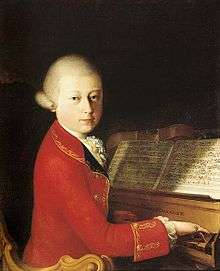Mass in G major, K. 49
| Missa brevis in G major | |
|---|---|
| Mass by W. A. Mozart | |
 The composer in 1770 | |
| Key | G major |
| Catalogue | K. 49/47d |
| Composed | 1768: Salzburg |
| Movements | 6 |
| Vocal | SATB choir and soloists |
| Instrumental |
|
Mozart's Mass in G major, K. 49/47d), is his first full mass. It is a missa brevis scored for SATB soloists and choir, violin I and II, viola, and basso continuo.
Mozart wrote the Mass in G major at the age of 12. It was however neither his first setting of a part of the mass ordinary — two years earlier he had already composed a Kyrie (K. 33) —, nor was it his largest composition with a religious theme up to date: his sacred musical play Die Schuldigkeit des ersten Gebots had been premiered in the previous year.
History
Composed in Vienna in the autumn of 1768,[1] this mass is Mozart's only missa brevis to feature a viola part.[2] It is not clear what occasion it was composed for, and it has been confused with the Waisenhausmesse, composed in the same year.[3]
Religious music at the time was increasingly influenced by opera and Baroque embellishments in instrumentation; Mozart's early masses, such as K. 49/47d, have been seen as a return to the more austere settings of the pre-Baroque era.[4]
Movements
The six movements of the mass follow the traditional Order of Mass:
- Kyrie Adagio, G major, common time
- "Kyrie eleison" Andante, G major, 3/4
- Gloria Allegro, G major, common time
- Credo Allegro, G major, 3/4
- "Et incarnatus est" Poco Adagio, C major, cut common time
- "Et resurrexit" Allegro, G major, cut common time
- "Et in Spiritum Sanctum" Andante, C major, 3/4; bass solo
- "Et in unam sanctam" Allegro, G major, cut common time
- Sanctus Andante, G major, 3/4
- "Pleni sunt coeli et terra" Allegro, G major, 3/4
- "Hosanna in excelsis" Allegro, G major, 4/2
- Benedictus Andante, C major, 3/4; soloist quartet
- "Hosanna in excelsis" Allegro, G major, 4/2
- Agnus Dei Adagio, G major, cut common time
- "Dona nobis pacem" Allegro, G major, 3/8
References
- ↑ Einstein, Alfred (1945). Mozart: His Character, His Work. p. 326.
- ↑ Eisen, Cliff; Keefe, Simon, eds. (2006). The Cambridge Mozart Encyclopedia. p. 272.
- ↑ Melograni, Piero (2007). Wolfgang Amadeus Mozart: A Biography. p. 27.
- ↑ Maragh-Ablinger, Renate. Wolfgang Amade Mozart. p. 51.
External links
- Missa brevis in G K. 49 (47d): Score in the Neue Mozart-Ausgabe
- Free scores of Missa Brevis No. 1 in the Choral Public Domain Library (ChoralWiki)
- Missa Brevis No. 1: Scores at the International Music Score Library Project (IMSLP)
